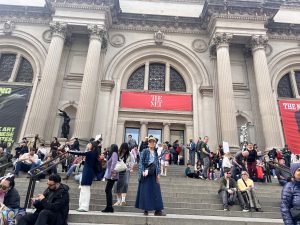The 2025 Met Gala returned in full dazzle under the theme “Superfine: Tailoring Black Style,” with Rihanna confirming her pregnancy in a striking Marc Jacobs suit. The annual high-fashion spectacle—more than just a celebrity showcase—also featured the surprise appearance of former Vice President Kamala Harris and nodded to Black dandyism and the power of fashion in shaping identity. Amid global unrest, the Met Gala offered a stylish reprieve for millions of fans worldwide.
The Evolution of the Met Gala and 2025’s Bold Theme
The Met Gala began in 1948 as a modest fundraiser for the Costume Institute at New York’s Metropolitan Museum of Art. Over time, it transformed into fashion’s most prestigious night, largely shaped by Vogue editor-in-chief Anna Wintour, who has chaired the event since 1995. Each year, the Gala raises millions for the museum’s fashion department and sets the tone for cultural conversations about style.
In 2025, the theme “Superfine: Tailoring Black Style” drew attention to the significance of Black dandyism in fashion history, particularly how tailoring has played a central role in identity formation among Black communities.  Guests walked the blue carpet in reimagined suits, cravats, dramatic accessories, and textured fabrics that paid tribute to both heritage and haute couture. One of the evening’s most anticipated moments came when Rihanna—long known as fashion royalty—confirmed her third pregnancy in a deconstructed pinstripe suit by Marc Jacobs, complete with a wide-brimmed hat and polka-dot cravat .
Guests walked the blue carpet in reimagined suits, cravats, dramatic accessories, and textured fabrics that paid tribute to both heritage and haute couture. One of the evening’s most anticipated moments came when Rihanna—long known as fashion royalty—confirmed her third pregnancy in a deconstructed pinstripe suit by Marc Jacobs, complete with a wide-brimmed hat and polka-dot cravat .
From Red Carpet to Capitol Hill: Politics Meets Couture
The Met Gala guest list is famously exclusive. Curated by Anna Wintour herself, it includes a blend of designers, entertainers, philanthropists, and cultural influencers. In 2025, former Vice President Kamala Harris joined the ranks of political figures who’ve stepped onto fashion’s most prestigious carpet. While she skipped the official blue carpet photos, Harris appeared inside the event with husband Doug Emhoff, donning a custom off-white gown designed by Ib Kamara. Her appearance came just days after her first public address following her 2024 electoral defeat, marking a deliberate post-political reemergence.
entertainers, philanthropists, and cultural influencers. In 2025, former Vice President Kamala Harris joined the ranks of political figures who’ve stepped onto fashion’s most prestigious carpet. While she skipped the official blue carpet photos, Harris appeared inside the event with husband Doug Emhoff, donning a custom off-white gown designed by Ib Kamara. Her appearance came just days after her first public address following her 2024 electoral defeat, marking a deliberate post-political reemergence.
 She joins a shortlist of political guests in Met Gala history. In 2021, Rep. Alexandria Ocasio-Cortez drew headlines with a dress that read “Tax the Rich,” while NYC Mayor Eric Adams appeared in 2022 in a coat bearing the message “End Gun Violence.” These moments blur the lines between policy and pop culture—highlighting how the Met Gala has become a platform not just for designers, but for statements.
She joins a shortlist of political guests in Met Gala history. In 2021, Rep. Alexandria Ocasio-Cortez drew headlines with a dress that read “Tax the Rich,” while NYC Mayor Eric Adams appeared in 2022 in a coat bearing the message “End Gun Violence.” These moments blur the lines between policy and pop culture—highlighting how the Met Gala has become a platform not just for designers, but for statements.
Why the Met Gala Matters—More Than Just Glamour
While often seen as a celebrity parade, the Met Gala’s core mission is philanthropic. The proceeds benefit the Costume  Institute’s exhibitions, acquisitions, and public programs. But beyond fundraising, the Gala provides a global cultural barometer—reflecting changing norms, celebrating innovation, and creating an annual snapshot of artistic expression.
Institute’s exhibitions, acquisitions, and public programs. But beyond fundraising, the Gala provides a global cultural barometer—reflecting changing norms, celebrating innovation, and creating an annual snapshot of artistic expression.
The event fosters partnerships across art, fashion, media, and social causes. In 2025, stars like Zendaya, Diana Ross, Sabrina Carpenter, Charli XCX, and Lauryn Hill joined in representing this fusion of fashion with Black excellence. Hill’s attendance, in a yellow tailored suit by Emefa Cole, marked her first red carpet in nearly a year.
Takeaway: A Cultural Pause in the Midst of Global Strain
In a world still reeling from inflation, global storms, embargoes, and ongoing war, the 2025 Met Gala offered a brief commercial break—a moment for collective breath. For fans of fashion, art, and culture, it was more than spectacle. It was a reminder that even amid upheaval, creativity persists. From the artistic tailoring of Black style to Rihanna’s joyful reveal, this year’s Gala celebrated resilience, self-expression, and unity through design.
As headlines deliver sobering news daily, this event—despite its glamour—offers a kind of cultural grounding. One that reminds us how identity, celebration, and heritage remain essential, even in difficult times.


